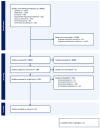High-dose chemotherapy as initial salvage chemotherapy in patients with relapsed or refractory testicular cancer: a systematic review and meta-analysis
- PMID: 39411122
- PMCID: PMC11473300
- DOI: 10.3389/fonc.2024.1437574
High-dose chemotherapy as initial salvage chemotherapy in patients with relapsed or refractory testicular cancer: a systematic review and meta-analysis
Abstract
Background: The role of high-dose chemotherapy followed by autologous hematopoietic cell transplantation in the management of patients with relapsed/refractory germ-cell tumors has not been established in prospective studies. Our aim was to estimate the benefits and harm of this treatment in men with relapsed/refractory germ-cell tumors.
Methods: Electronic databases, conference proceedings, and trial registers until April 30, 2023, were searched. Randomized and non-randomized prospective controlled trials were included. Risk of bias assessments were performed using either RoB2 or ROBINS-I tools. The certainty of evidence was assessed using the Grading of Recommendations, Assessment, Development, and Evaluations (GRADE) approach. Time-to-event data were analyzed using the hazard ratio. The primary outcome was overall survival, and a meta-analysis was not conducted to assess it because non-randomized trials were judged to have a critical risk of bias. Categorical data were analyzed using a risk ratio. All results are presented with the corresponding 95% confidence interval.
Results: Four out of 3,824 records met the inclusion criteria, and three out of four were used to assess primary and secondary outcomes. Based on the IT94 study (N = 263 participants), single high-dose chemotherapy followed by autologous hematopoietic cell transplantation may have little to no effect on overall survival [hazard ratio (HR) 0.98, 95%CI 0.68 to 1.42; p = 0.916]. Non-randomized trials (N = 43 participants) showed contrasting results, which may be explained by the number of cycles of high-dose chemotherapy administered in each study. Regarding secondary outcomes, information was only provided for event-free survival, response rate, and acute toxicities.
Conclusions: Based on prospective data, there is insufficient evidence to support or refute the proposal that high-dose chemotherapy with autologous hematopoietic cell transplantation improves survival in men with relapsed/refractory germ-cell tumors. If this treatment is considered essential, the choice should be made by experienced clinicians at high-volume cancer centers.
Keywords: adverse (side) effects; chemotherapy; high dose chemotherapy with autologous stem cell transplantation; refractory germ cell tumors; relapsed germ cell tumor; survival.
Copyright © 2024 Briones, Diaz and Nicholson.
Conflict of interest statement
The authors declare that the research was conducted in the absence of any commercial or financial relationships that could be construed as a potential conflict of interest.
Figures










References
-
- International Prognostic Factors Study Group. Lorch A, Beyer J, Bascoul-Mollevi C, Kramar A, Einhorn LH, et al. . Prognostic factors in patients with metastatic germ cell tumors who experienced treatment failure with cisplatin-based first-line chemotherapy. J Clin Oncol. (2010) 28:4906–11. doi: 10.1200/JCO.2009.26.8128 - DOI - PubMed
Publication types
LinkOut - more resources
Full Text Sources
Miscellaneous

